INSTITUTE OF PHILOSOPHY OF NATURE
Abstract
Extensive studies have been carried out to understand the mechanism of thunderstorm electricity. Despite the use of modern measurement techniques and advanced theoretical treatment, the significant physics in micro and macro scales are still not clear. Besides the thunderstorm electricity, fair-weather electric field has been well recorded. The author considers the charge state of the surface of the earth and its atmosphere to be more fundamental. The charge polarisation of the atmospheric shells provides an appropriate answer to the fair-weather field. The fair-weather global field undergoes modification with the formation of cloud in the field medium. This new consideration agrees well with the observed electric structure in the cloud.
Key words: Thunderstorm electricity, Fair-weather electricity, Air-earth current, Cloud precipitation, Precipitation model of cloud charging, Convection model of cloud charging, Tripole electric structure.
Introduction
Benjamin Franklin in the year 1752, for the first time demonstrated that lightning bolt is a giant electric discharge. This means, lightning is a transfer of either positive or negative charge from one region of the cloud to another or between the cloud and the earth. Since then, numerous investigations have been carried out to understand the mechanism of electrification of cloud. Despite the use of modern equipments, advanced techniques and improved theoretical treatment, the origin of electrification of clouds remains elusive. Even today, the significant physics for both in micro and macro scales is missing [1].
A cloud having the positive charge at the uppermost region and the negative charge in the lowermost region is conventionally known to have a positive dipole electric structure and the cloud with a reverse polarity charge has negative dipole structure. Prior to 1885 Julius Elster and Hans. F. Geitel for the first time proposed the precipitation hypothesis to explain the positive dipole structure in cloud. The hypothesis assumes that rain drops; hailstones and gaupel particles (millimetre to centimetre size ice pellets) in thunder cloud are pulled by gravity downward which passes through the air containing smaller water droplets and ice crystals in suspension [2]. This permits collision of precipitated particles with the mist of water droplets and ice crystals where it is conjectured that negative charge is transferred to the precipitated particles and positive charge to the mist. Due to the negative charge of the precipitated particles, the lower part of the cloud accumulates negative charge while the upper part accumulates positive charge (Fig.1). By this explanation, the charge structure in cloud was justified to have a positive dipole as a regular feature.
In 1920 Wilson made observations of a large number of thunder storms from a distance by measurement of electric field produced by a charged cloud and inferred that the basic structure of thunder cloud was that of a positive dipole. At about the same time Simpson made measurements of charge on the rain falling from the thunder cloud and concluded that the lower region was positively charged while the upper was negatively charged. This Wilson – Simpson controversy could not be resolved for about 50 years, till observations established that the basic structure is not dipolar but tripolar [3]. While the Wilson-Simpson controversy was going on, a new convection hypothesis was independently suggested by Gaston Grenet in 1947 and Bernard Vonnegut in 1953 to explain the dipole structure of thundercloud. In this model the positive ions formed by the corona discharge from the sharp objects on the surface of the earth are carried upward by warm air (convection) like the belt of the Van de Graaf Generator [3]. After reaching the upper region of the cloud, these positive ions attract the negative ions above the cloud which are formed by ionizing cosmic rays. The negative ions enter the cloud and quickly attach themselves to the water droplets and ice crystals, thereby forming a negatively charged “screening layer”. By hypothesis the down drafts at the cloud periphery then carry downward the negatively charged particles from the screening layer. This leads to the formation of positive dipole [3] structure (Fig.2). It may be mentioned here that both precipitation and convection hypotheses were developed to explain the positive dipole structure known by then. They, however, faced serious limitations in explaining the tripole structure observed subsequently.
It is now established beyond doubt that the basic structure of thundercloud is not dipolar but tripolar [3]. The important feature of the tripole structure is described here with reference to Fig.3. There is a main region of negative charge in the central zone with one region of positive charge above it and a second smaller region of positive charge below it. The remarkable features of the negatively charged main layer are having pancake [4] shape with its vertical thickness less than a kilometre. On the other hand, the main negative charge extends several kilometres or more horizontally.
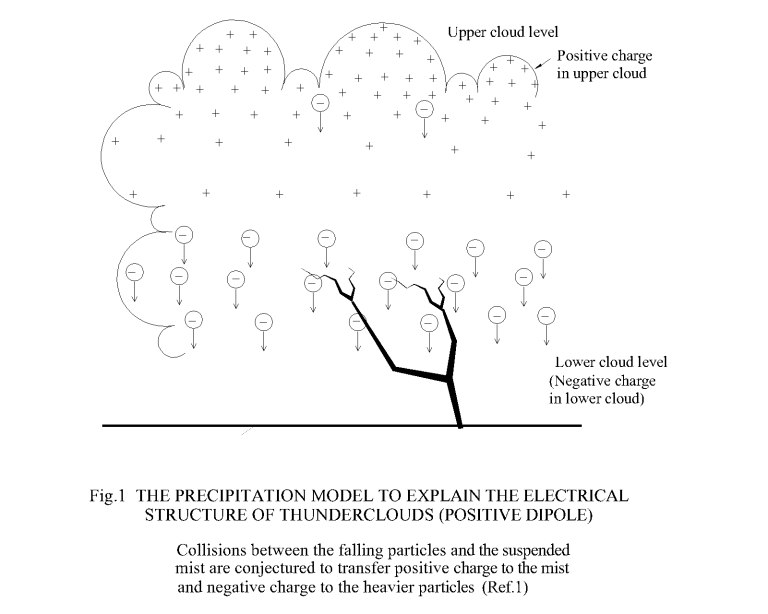
The main negative charge is located at an altitude of 6 km. Very large electric fields are seen in thunder clouds at upper and lower boundaries of this negatively charged layer. The upper region of positive charge is more diffused and may extend vertically several kilometers up to the top height of the clouds. The lower region of positive charge, on the other hand, is so small that the electric field at the surface is frequently dominated by the main negative charge. One additional feature is also seen in many clouds where a thin layer of negative charge of about 100 meters thick is found above the upper positive region. The tripolar structure of the cloud resolved the long-standing Wilson – Simpson controversy.
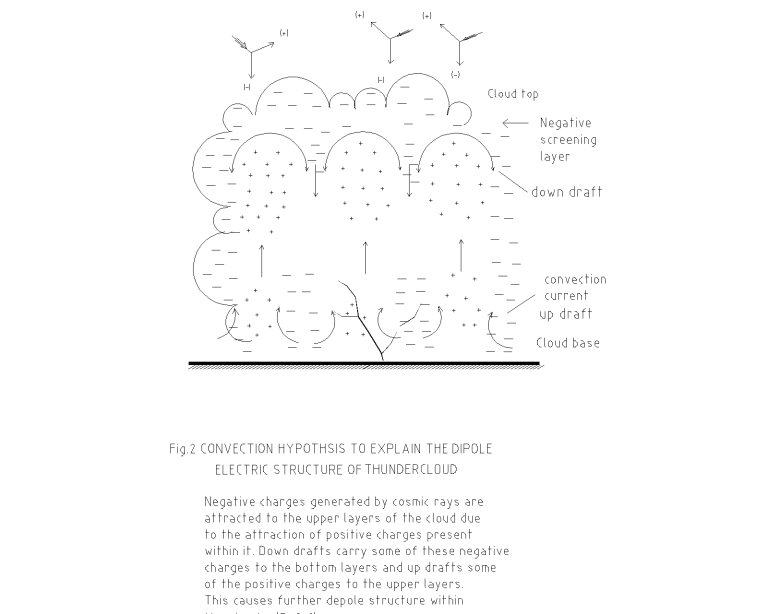
Wilson made electric field measurement from a distance where the small positive region at the base of the cloud was overwhelmed by the strong negative field produced by the main negative charge. On the other hand, Simpson’s observations were carried out right under the cloud where his instruments detected the lower positive region directly above him. Since the higher negative central region screened the top positive region, Simpson concluded that the negative charge was the upper most. Both the precipitation hypothesis and the convection hypothesis faced problems in justifying the formation of a tripolar structure in cloud. It may be seen from the following discussion that none of the two hypotheses is sound enough to explain the observed natural phenomena.
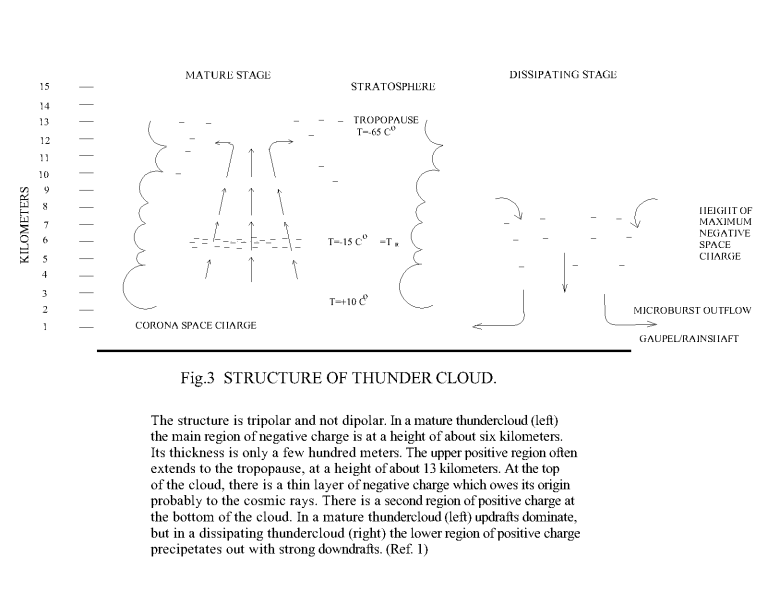
The strength and weakness of convection and precipitation models
Both the models have many weaknesses and thus, when any one model fails to provide answer for some fact, the other becomes a string of hope. This is discussed systematically in the following analysis.
- The naive precipitation model was basically developed to explain the positive dipole structure and it miserably fails to explain the tripolar structure. Not only the model requires modification but also the micro physics of charge transfer remains to be explained.
- The convection model appears more natural towards explaining the tripolar structure as it assumes a corona discharge from the sharp objects on the earth which permits the formation of lower positive charge at the base of the cloud. However, the actual flux measurement suggests that it may be an order of magnitude smaller than that required to justify the rate of charging.
- When the flux measurement did not agree with the convection model, the precipitation hypothesis gained its importance with several modifications. Modifications were made primarily to explain the lower positive charge. Simpson found the rain drops ordinarily carring positive charge. His studies on rain fall gave an empirical knowledge that larger droplets selectively acquire positive charge on break up. He then implanted this empirical knowledge in explaining the lower positive charge by assuming that the precipitating water droplets in the thundercloud also fragmented near the base of the cloud which then accounted for the lower positive charge. This model again failed like the convection model when the measurement was made under the main negative charge region of the thundercloud. Measurement showed that the charges in precipitated particles are substantially greater than those produced by water fall fragmentation. It was also noted that the positively charged particles that fell below the main negative charge were ice particles having little scope for fragmentation.
- When charging by fragmentation did not succeed, then charging by ice melting was considered. Laboratory experiment in 1940’s showed that ice particles picked up strong positive charge in the course of melting. It may be noted here that ice melts only at an altitude below 4000 meters. Hence, this model failed to justify any pickup of positive charge at altitudes over 4000 meters.
- Collision between ice crystals and gaupel particles was then anticipated for the precipitation model. Many investigations have shown that the polarity of charge, transferred to the particles is strongly temperature dependent. Below a critical temperature, negative charge is transferred and at higher temperatures, positive charge is transferred. This critical temperature is the charge reversal temperature. The lower positive charge region in the tripolar structure remains above the charge reversal temperature. Thus the temperature dependent charge transfer has some stand in explaining the lower positive charge. This model does not invoke any convection which is an important part of the cloud dynamics. There is substantial evidence that thunderstorms are regions of vigorous up-drafts and down-drafts indicating that convection is indisputably present. For this reason, many think that the convection hypothesis is perhaps close to reality.
It was observed that the maximum lightning flash rates are associated with upward motion of gaupel and hail stones above the main negative region. This again contradicts the naive precipitation model where the downward motions of gaupel particles are assumed.
- The argument was in favour of the convection hypothesis and it was thought that strong convection currents being the characteristic feature of thunderstorms is probably linked to cloud electrification. The convection hypothesis, however, does not predict the screening layer above the upper positive zone.
Charge structure in low atmosphere and in clouds- a new concept
Electric charge field is seen to exist both in disturbed and fair-weather condition as a global phenomenon and it has a highly organized structure. Though the charge phenomenon is quite conspicuous during the storm, the presence of electrical field is quite common in fair-weather condition. Thus, one can’t attribute the cause of electrification in lower atmosphere as an exclusive feature of thundercloud. Even though the rain clouds are always active at some part of the world, it is difficult to explain the exact nature of fair-weather electric field and the air earth current. Hence, the mechanism of cloud charging does not essentially confine to the cloud pockets only. Rather, it (charge structure in cloud) could be interpreted as a local modification of global fair-weather charge field structure due to the variation in dielectric property of atmospheric medium (air) with the formation of cloud pockets. It may be mentioned here that the electrical conductivity of cloud is one order lower than that of the air.
So far, our attempts to understand the electric structure in cloud were to discover a charging mechanism (charge separation in micro scale) and find a means for the migration of charge (charge separation in macro scale) by attributing to a cause from and within the thundercloud and rainfall. Events like cloud precipitation, convection etc. those associated with the thundercloud could not provide success in bringing up a satisfactory model even though nearly two and a half centuries have already passed since the first identification of electric discharge in thunderclouds. Perhaps the present approach to understand the cloud electrification by attributing the cause from within and around the cloud is not in the right track. The precipitation theory makes use of many conjectures, the physics of which in micro domain is yet to be established. For example, the conjecture that collision of precipitated particles with the mist of water droplet and ice crystals would result in transfer of negative charge to the precipitated particles and positive charge to the mist, needs to be substantiated using physics. The convection theory does not take into account the charge forces when the charges of one polarity are accumulated by convection. It may be mentioned here that the convection process is carried out by the action of gravity which is by far weaker than the charge interaction forces. It thus becomes impossible to make cloud charging by convection. On the other hand, any development of electric charge in cloud by some other mechanism would make a vertical movement of the cloud causing convection and storm. It is not surprising to find that a definite electric potential favours precipitation rather than precipitation causing electric charging of cloud. This fact may be analysed from the failure of large number of experiments to make artificial rain fall by seeding.
It would be preferable to understand first the fair-weather electric structure as it is a global feature and then interpret the local charge phenomena in the thundercloud as a specific modification of the global charge feature under local conditions.
Global charge structure
It is well known that the earth is negatively charged with respect to the atmosphere above. No satisfactory answer is available for this. Thus, we do not know as to how the earth is negatively charged? It is not the case for the earth alone. We do not know as yet, how the electrons or the protons are negatively charged. These require deeper understanding of the charge itself, and its bearing with mass etc? May be, a clear understanding of the mechanism of the negative charging of the earth will give us the clue to know how in electron and proton are characteristically charged. The objective of this paper being only to analyse the charge structure in the thundercloud, we will confine the discussion to the subject.
The surface (crust) of the earth being negatively charged, it organises a charge field structure with alternate positive and negative ionospheric charge shells [1]. These charged shells may be called primary charge shells. The first positive primary charge shell is located at a height of 47 km from the surface of the earth. This positively charged shell also contains negatively charged particles but less in number. Between the negatively charged earth and the positively charged atmosphere (ionosphere) there exists a potential gradient (electric field). Due to this impressed vertical electric field, the negative and positive charges in the atmospheric medium cause further polarisation resulting formation of electrically charged sub-shells. It is also said that the spacing of the sub-shells exhibit an outwardly expanding order of spacing starting from the surface of the earth or any other main shells [1]. The sub-shell again being composed of sub-sub-shells and so on, a complex electric structure is developed up to 47 km (Fig.4). Ions formed by any energetic process migrate to their equilibrium position by the action of gravity and charge forces. The new charge shell, sub-shell concept in the atmosphere allows a free-standing atmosphere without getting settle down to the surface. This electric structure corresponds to the polarised field in fair-weather condition. Like the movement of ionospheric charges in primary shells responding to the attraction from the sun and the moon, the motion of charge particle in sub-shells also occurs. We shall now examine how this fair-weather potential assumes a higher charge density within the thundercloud.
The electrical resistivity is one order higher for the cloud than that of air. Thus, the cloud remains almost electrically isolated from the other part of the atmospheric shell. The horizontal electrical conductivity being poor in the cloud, the charges do not migrate globally as it happens in atmospheric air. The absorption of solar radiation causing photo ionisation increases in cloud as compared to clear air. The excess ions migrating to their respective equilibrium position in different shells, sub shells, sub-sub-shells increase the charge density significantly as the horizontal conduction is poor within the cloud. The vertical conduction is still more difficult as it has to overcome additionally the polarised potential barrier. Once the potential increases significantly in a disproportionate manner in excess of the equilibrium value, it ruptures the dielectric medium giving rise to an electric discharge. This discharge takes place vertically following the path of least resistance. Once the electric discharge takes place, the charge potential in the shells, sub-shells … abruptly change due to temporary rupture of the dielectric barrier. This causes violent vertical movement of the charged cloud resulting in storms. Changes in the electric potential caused by electric discharge promote precipitation of the cloud. Thus, neither convection nor precipitation is fundamental to cloud charging mechanism; they are only the after effects of electric discharge.
Ionisation within the cloud can be accounted for by the solar ionising radiation, collision process within the cloud, ionizing radiation from ground based nuclear material, ionising radiation from the atmospheric dusts of nuclear materials, cosmic rays, corona discharge from the sharp objects and high voltage transmission lines etc. But once the neutral atoms and molecules are ionized, the ions move vertically to their respective equilibrium positions in shell, sub-shell locations. This is how the positively and negatively charged cloud layers confirm to the definite heights determined by the global charge structure (Fig.3, Fig.4 and Fig.8.5). Now perhaps it may be feasible to make artificial rainfall by triggering the lightning discharge among the shell-sub shell under suitable charge conditions. One can as well draw power from the atmospheric charged shell by linking the shells/sub-shells through a narrow ion column generated by sending an appropriate laser beam from the ground.
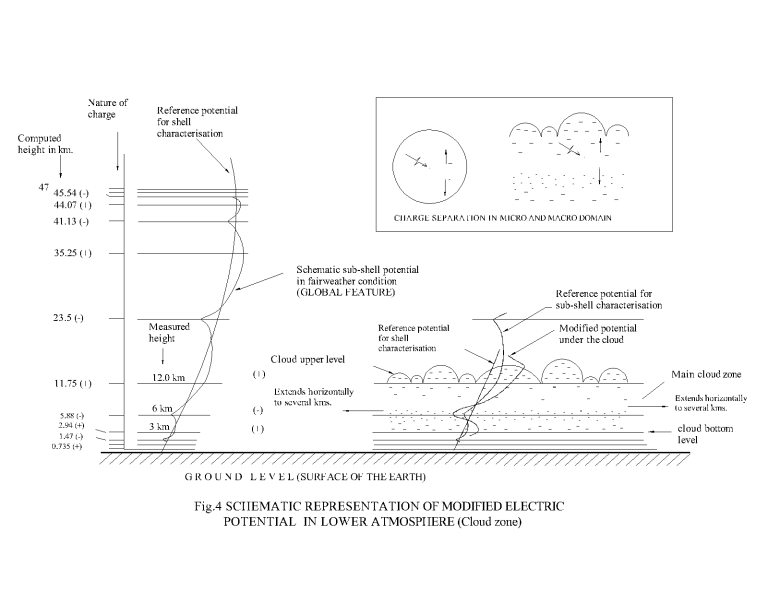
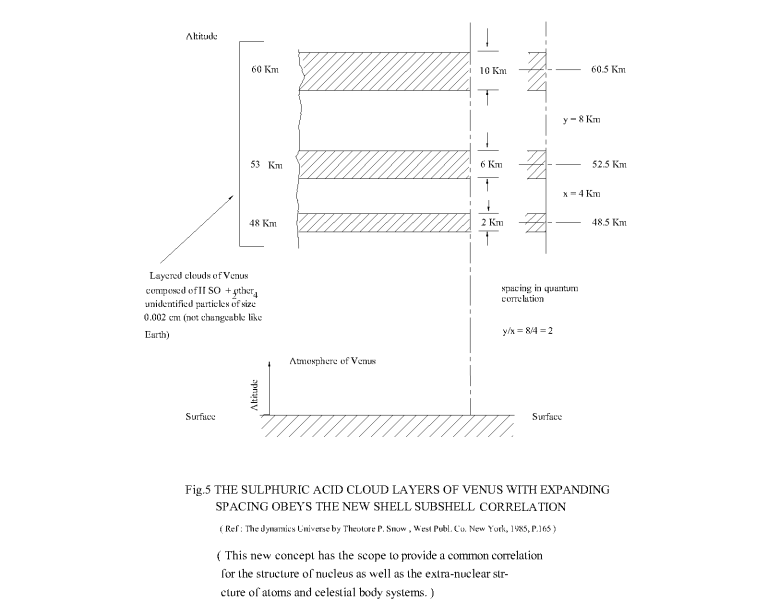
One would ordinarily expect all lightning discharge to take place towards late afternoon when the cloud charging reaches a maximum potential. However, there are variations in this timing because of the unevenness of the negatively charged surface of the earth. The mountains and forests when come under the cloud, the triggering of electric discharge also takes place.
Conclusion
The earth as a negatively charged body explains the cloud dynamics more clearly. As reported in earlier articles, other charge phenomena such as an ionosphere, aurora, geomagnetism, Van-Allen Belt, magnetospheres are also understood in a better way by assuming the earth to be negatively charged. In view of this the solar system has a closer resemblance with the atomic system as far as the electric charge and the discrete orbit is concerned. It appears a common universal dynamic for the atomic and solar system may be feasible in future.
This article is a part of the original work published in the book “Planetary electrodynamics-1”, Volume-1 of the series “Dynamics of universe; interplay of matter, space and charge”, 1998 by the same author.
References
- Williams, E.R., Sc. American, Nov.1988, p.48.
- Ibid. p.49.
- Ibid, p.51.
- Ibid, p.50.
- Ibid, p.48.

Hello there, just became alert to your blog through Google,
and found that it’s truly informative. I
am going to watch out for brussels. I’ll be grateful if you continue this in future.
Lots of people will be benefited from your writing. Cheers!
Thank you very much for your valuable comment.
Hello There. I discovered your blog the usage of msn. This is a
really well written article. I’ll be sure to bookmark it and come back
to read more of your helpful information. Thank you for the post.
I will definitely comeback.
Thank you very much for your valuable comment.
What you’ve written here is not just a collection of ideas — it’s a conversation, one that spans across time and place. Your words evoke such a rich tapestry of images and emotions that it’s impossible not to be swept up in them. There’s an intimacy to the writing, a quiet understanding that connects the reader to something much larger than themselves.
Thank you for taking the time to read my article so thoughtfully. Your insightful comments are truly remarkable and have inspired the author to continue writing on the emerging field of a unified, comprehensive science.
I like what you guys are up also. Such intelligent work and reporting! Carry on the excellent works guys I’ve incorporated you guys to my blogroll. I think it’ll improve the value of my site 🙂
Hi, Neat post. There’s a problem with your web site in internet explorer, would test this… IE still is the market leader and a huge portion of people will miss your great writing because of this problem.
You really make it seem really easy along with your presentation however I find this matter to be actually something which I think I would by no means understand. It kind of feels too complicated and extremely vast for me. I am having a look forward in your subsequent post, I will attempt to get the hold of it!
I consider something genuinely interesting about your weblog so I saved to bookmarks.
What i don’t realize is in reality how you are now not actually a lot more well-appreciated than you might be right now. You’re so intelligent. You recognize therefore significantly on the subject of this matter, made me individually imagine it from a lot of various angles. Its like women and men are not fascinated unless it is something to accomplish with Girl gaga! Your personal stuffs nice. All the time deal with it up!
I’m really impressed with your writing skills as well as with the layout on your blog. Is this a paid theme or did you customize it yourself? Either way keep up the nice quality writing, it is rare to see a great blog like this one these days..
I haven¦t checked in here for some time since I thought it was getting boring, but the last several posts are great quality so I guess I will add you back to my daily bloglist. You deserve it my friend 🙂
Thank you for your comment on my articles.
As soon as I observed this internet site I went on reddit to share some of the love with them.
Someone essentially help to make significantly posts I’d state. That is the very first time I frequented your website page and to this point? I amazed with the analysis you made to create this actual submit extraordinary. Fantastic job!
I was very pleased to find this web-site.I needed to thanks on your time for this glorious read!! I positively enjoying each little little bit of it and I have you bookmarked to check out new stuff you weblog post.
I am not really fantastic with English but I get hold this really leisurely to understand.
I’ve been following this issue for a while, and your analysis adds a crucial dimension I hadn’t considered before. The historical context you provided helps explain current developments in a way that’s both clear and compelling. This has given me much to think about.